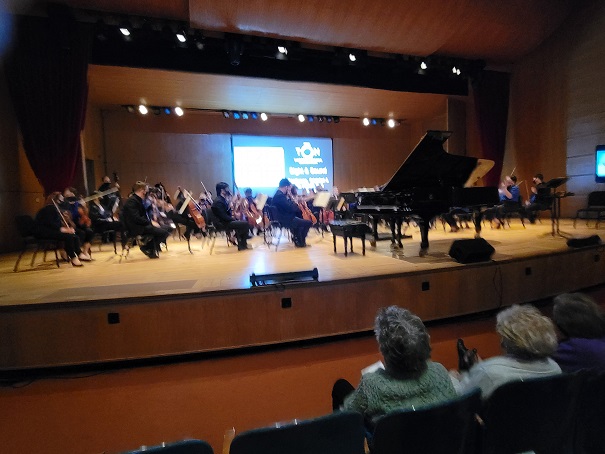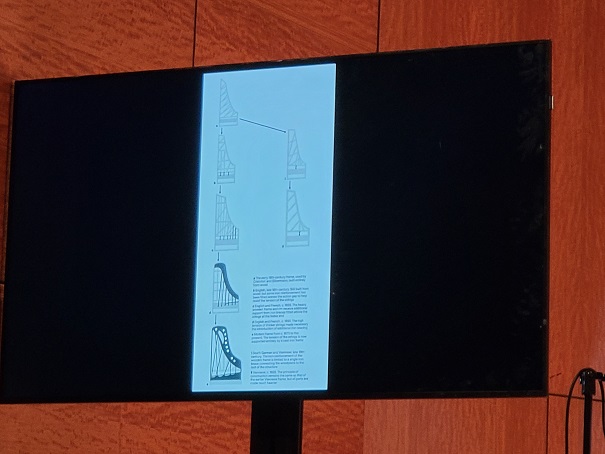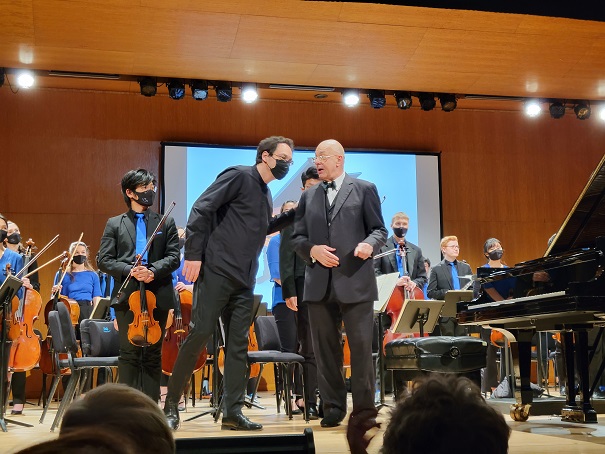Concert Diary: Beethoven’s Piano Concerto No. 5
December 5, 2021
New York, N.Y.
When you sit down to a concert, you want your mind to be calm and relaxed and ready to absorb great music. You don’t want to be anxious and agitated and enraged at the incompetence of the people running the show.
Welcome to the Metropolitan Museum, where Met Live Arts perversely decided that everybody attending Sunday afternoon’s concert of The Orchestra Now should be locked out of the street-level entrance specifically intended for the Grace Rainey Rogers Auditorium, and instead made to stand in a long line snaking through rooms 103, 101, 138, and 137 of the Egyptian Art section until perilously close to concert time.
Normal concert venues open their doors 30 minutes or (in these days of COVID) 45 minutes before concert time, giving enough time for checking vax cards, scanning tickets, finding seats, and allowing patrons to use the bathrooms. But not the Met Museum. For those of us wishing to use the bathroom before the concert, this ridiculously long and unnecessary line presented a quandary: Leave the line to use the bathroom and then get on the end of the line, or wait until seated and then use the bathroom with the additional anxiety of missing the beginning of the concert.
As it was, the event started some 15 minutes late while people where still coming in and trying to find their seats. Fortunately, this was an event featuring a discussion prior to the music, so we had time to calm down.
Met Live Arts likes to organize concerts that connect musical compositions with the museum’s artwork. I very much approvie, because neither music nor art can be removed from their historical contexts. Connections foster a synergistic understanding. This concert featured Beethoven’s Piano Concerto No. 5 (nicknamed the Emperor) but was entitled Beethoven, Cristofori & The Piano’s First Century, referring to the world’s oldest existing piano — the 1720 Christofori on display in the Met Museum’s Musical Instrument collection. Bartolomeo Cristofori (1655 – 1731) is considered to be the inventor of the piano, having established several crucial features that persisted in subsequent designs.
The concert was hosted and conducted by Leon Botstein, who is President of Bard College and founder of The Orchestra Now, whose student musicians were already occupying a crowded stage as we entered:
The pianist was Shai Wosner, who a decade ago endeared himself to my heart by recording an album that combined tracks of Johannes Brahms and Arnold Schoenberg in an exceptionally promiscuous and revealing fashion.
The connection between Beethoven and the 1720 Cristofori is tenuous at best, considering that this piano was built 50 years before Beethoven was born, and Beethoven never played a Cristofoi piano. But the piano in general was exceptionally important to Beethoven’s music, and in a fascinating pre-concert talk, Leon Botstein took us through the subsequent history of the piano, describing how the various innovations during Beethoven’s lifetime in range, dynamics, and action, allowed him to expand his musical vocabulary.
To illustrate this, Shai Wosner and The Orchestra Now played excerpts from Beethoven’s 5th Piano Concerto, contrasted with some excerpts from the 1st and 4th Piano Concertos. Less successful were several slides displayed on monitors on the sides of the stage that were intended to display the mechanism and evolution of pianos. This is not the only illustration that could have been reformatted a bit for a landscape monitor:
I couldn’t read it and I was sitting in the third row. Also disappointing was the lack of sound samples of these historical pianos. The piano used in the performance of the Concerto was a modern Steinway. It would have been nice to hear a piano from Beethoven’s era, but I suspect that would have required that the rest of the orchestra play period instruments as well.
I had previously only heard chamber music in the Grace Rainey Rogers Auditorium, and the acoustics seemed a little off for an orchestral performance, but I loved the energy of these students and Shai Wosner’s intelligent performance. The first movement is mostly triumphant and heroic and even militaristic — check out the analysis on “Beethoven’s Military Style” by Alfred Einstein that I quoted in my entry on 5th Piano Concerto in The Complete Beethoven — but in Shai Wosner’s performance I found myself cherishing the softer, eerier, more magical moments.
That Adagio is one of Beethoven’s great slow movements. To me it’s the heart of the composition. It’s so good that Leonard Bernstein couldn’t help but rip it off for the setting of the words “There’s a place for us” in his song “Somewhere.” Like most great Romantic concertos, the final movement is unambiguously joyous, a rollicking dance in 6/8 time.
Here’s Shai Wosner and Leon Botstein and The Orchestra Now during curtain calls:
The next concert of The Orchestra Now at the Met is in February and focuses on Picasso, Cubism, and Stravinsky. I’m very much looking forward to it. Maybe by then Met Live Arts will have figured out basic audience logistics that other venues have long ago mastered.


